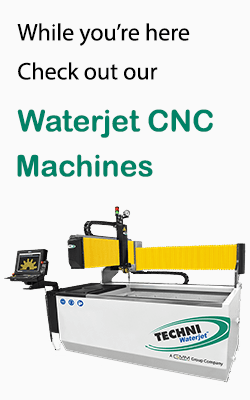We have told you multiple times, in various articles, about the different materials that you can cut with a waterjet cutter. However, besides the wide range of materials, there are also many different ways in which you can cut.
For instance, did you know you can cut any material underwater with a waterjet cutter? Yes, that is true.
Any good waterjet cutter, such as Techniwaterjet’s entire range of CNC water jet cutters, allows you to cut with your workpiece out of the water or under it.
This raises some obvious questions, like ‘what is this underwater water jet cutting?’ and ‘is there any benefit to the process?’ Let us find out:
What is Underwater (Submerged) Waterjet Cutting?
The explanation of submerged waterjet cutting lies in its name itself.
In underwater cutting, the water on the table is raised to cover the workpiece and the cutting head. In this cutting method, the level of water on the table is controlled by the waterjet system itself.
This method is mostly followed for metal material such as titanium, stainless steel, aluminium, copper, etc. For non-metals, underwater cutting is applied for glass, wood, marble, and stone.
What are the Benefits of Underwater Cutting?
There are many reasons for which cutting underwater is the better way for abrasive water jet. Some of these reasons are:
Reduced Noise
When you are cutting metal materials or any other hard materials, any cutting process is going to emit a loud noise. The same goes for conventional abrasive waterjet cutting.
Generally, the noise in water jet cutting is very loud. This is because the water stream itself travels at a speed more than the speed of sound, creating air turbulence. Usually, operators need hearing protection when cutting materials over water.
However, when you implement the abrasive water jet cutting with the entire thing submerged, there is a significant noise reduction. This improves the overall operation and environment of the workshop with safe noise levels.
Eliminating Water Splash
In conventional abrasive waterjet cutting, once the water jet goes through the material, water splashing takes place. This not only wastes a lot of water but also leads to high risk due to stray abrasive particles.
Additionally, the splash creates a lot of mess in the cutting environment. It can get anywhere, from the electronic parts of the machine to the framework such as beams and railings. This can even cause the parts rust for the cutting machine due to metal material.
However, keeping the cutting head under water prevents stray splashes, since the water level absorbs most of the impact of the exit water stream. This leads to a safer and cleaner work environment.
Reduced Frosting
If you have overseen waterjet cutting, you might have seen the frosting effect on the surface of the material. This effect refers to the cloudy or rough finish that materials get due to impact with the stray abrasive particles.
This is an unwanted effect as it deteriorates the surface finish of the material. Since cutting underwater prevents any stray abrasive particles, there is negligible frosting in this method.
Avoids Rusting
Rusting occurs when a metal comes in contact with water and air at the same time. When cutting over water, the constant splash makes the metals wet. Additionally, the air present in the environment leads to an early rusting process in certain areas.
However, when cutting underwater, while the metal becomes wet there is no supply of air. The water cuts off the air entirely, so there is no chance of rusting in underwater cutting.
When to Choose Underwater Cutting Process Instead of Conventional Waterjet Cutting?
Cutting underwater has advantages for many applications, but it is not always the best choice for every material and situation.
While no one likes wearing hearing protection, there are certain situations in which conventional abrasive waterjets can be a better option.
- For beginners new to the water jet cutting process and unsure if they are doing it right, simply cutting using conventional machines might be the better option. This is because they can visually inspect what is going on while cutting.
- When cutting thin material underwater, the backsplash of the water can create an unwanted movement of the material. So, cutting thin material over water is a better way to go. It’s also true for materials that float on water.
- In the case of abrasive cutting of very thick material, it’s hard to have it completely submerged because the water level required would be too high. It might be better to adopt a conventional cutting approach.
Endnotes
Cutting under water for abrasive waterjets has been a blessing for most operators. The two main advantages of reduced noise and reduced mess alone make up for the slightly higher effort the process might require.
If you feel that submerged cutting is something you want to implement, you might want to look at Techniwaterjet’s water jet cutters. Techniwaterjet creates some of the most high-end submerged technology cutters which you can operate with ease.
The water level in these precision submerged cutters can be controlled by the operator and set as required. In the submerged state, the noise of the machine is almost negligible. This sound is the primary reason that most operators buy these machines.
Therefore, do check out these machines to find out what they are capable of.





